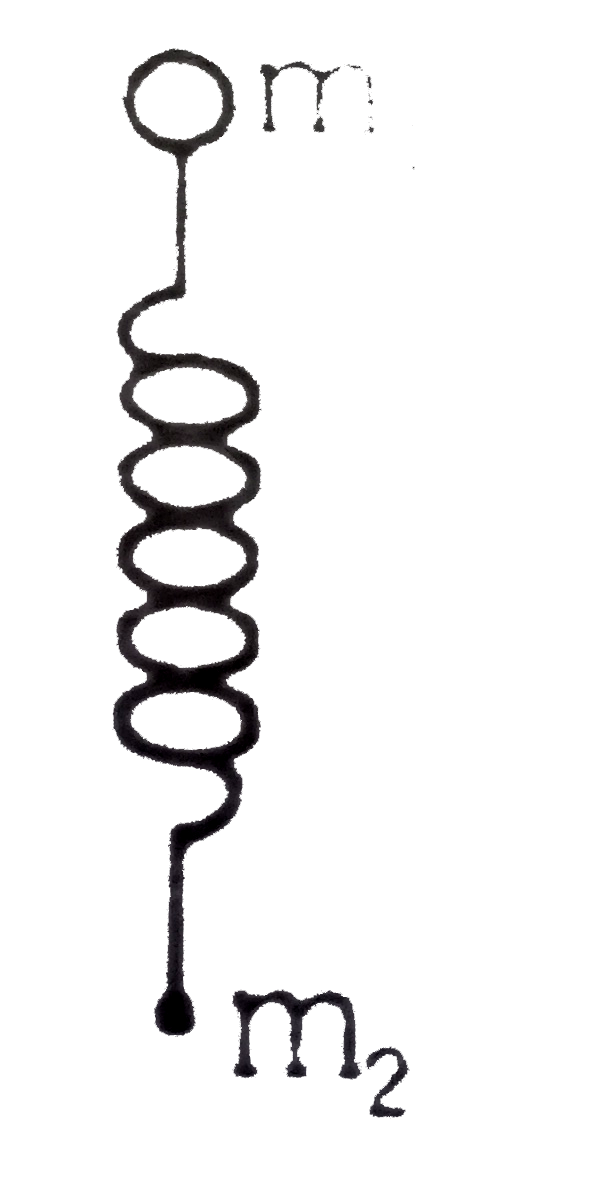Two small balls of the same size and of mass m1 and m2(m1>m2) are tied by a thin light thread and dropped from a large height. Determine the tension T of the thread during the flight after the motion of the balls has become steady. (Air resistance force is same on two balls)
[Take m1=2kg, m2=1kg, g=10m/s2]
To solve the problem, we need to analyze the forces acting on both balls after they have been dropped and the motion has become steady.
1. Identify the Masses and Forces:
- Let m1=2kg (the heavier ball) and m2=1kg (the lighter ball).
- The gravitational force acting on each ball is given by Fg=m⋅g, where g=10m/s2.
- Therefore, the weight of m1 is W1=m1⋅g=2⋅10=20N.
- The weight of m2 is W2=m2⋅g=1⋅10=10N.
2. Consider Air Resistance:
- Let the air resistance force acting on both balls be F (same for both due to the problem statement).
- The forces acting on each ball can be summarized as follows:
- For m1: Downward forces are W1 and upward forces are T (tension in the string) and F (air resistance).
- For m2: Downward forces are W2 and upward forces are T and F.
3. Set Up the Equations of Motion:
- Since the motion has become steady, the acceleration of both balls is zero (a1=0 and a2=0).
- For m2:
W2−T−F=0⟹10−T−F=0(Equation 1)
- For m1:
W1−T−F=0⟹20−T−F=0(Equation 2)
4. Subtract the Equations:
- Subtract Equation 1 from Equation 2:
(20−T−F)−(10−T−F)=0
Simplifying gives:
20−10=0⟹10=0
- This leads to:
2T=10⟹T=5N
5. Conclusion:
- The tension T in the thread during the flight after the motion of the balls has become steady is 5N.
- Let m1=2kg (the heavier ball) and m2=1kg (the lighter ball).
- The gravitational force acting on each ball is given by Fg=m⋅g, where g=10m/s2.
- Therefore, the weight of m1 is W1=m1⋅g=2⋅10=20N.
- The weight of m2 is W2=m2⋅g=1⋅10=10N.
- Let the air resistance force acting on both balls be F (same for both due to the problem statement).
- The forces acting on each ball can be summarized as follows:
- For m1: Downward forces are W1 and upward forces are T (tension in the string) and F (air resistance).
- For m2: Downward forces are W2 and upward forces are T and F.
- Since the motion has become steady, the acceleration of both balls is zero (a1=0 and a2=0).
- For m2:
W2−T−F=0⟹10−T−F=0(Equation 1)
- For m1:
W1−T−F=0⟹20−T−F=0(Equation 2)
- Subtract Equation 1 from Equation 2:
(20−T−F)−(10−T−F)=0
Simplifying gives:
20−10=0⟹10=0
- This leads to:
2T=10⟹T=5N
- The tension T in the thread during the flight after the motion of the balls has become steady is 5N.
Similar Questions
Two small balls of the same size and of mass m1 and m2(m1>m2) are tied by a thin weightless thread and dropped from a ballon. Determine the tension T of the thread during the flight after the motion of the balls has become steady-state.
View SolutionTwo masses m1 and m2(m1>m2) are falling from the same height when same air resistance acts on them
View Solution
Knowledge Check
- Question 1 - Select One
Two particles A1andA2 of masses m1,m2(m1>m2) have the same de-broglie wavelength. Then
Atheir momenta are the same.Btheir energies are the same.Cmomentum of A1 is less than the momentum of A2.Denergy of A1 is more than the energy of A2.
Two masses m1 and m2(m2>m1) are hanging vertically over frictionless pulley. The acceleration of the two masses is :
 View Solution
View SolutionTwo masses m1 and m2(m2>m1) are hanging vertically over frictionless pulley. The acceleration of the two masses is :
 View Solution
View SolutionTwo particles A1andA2 of masses m1,m2(m1>m2) have the same de-broglie wavelength. Then
View SolutionThe two masses m1 and m2 are joined by a spring as shown. The system is dropped to the ground from a height. The spring will be
 View Solution
View SolutionA ball is dropped from a height of 5 m, if it rebound upto height of 1.8 m, then the ratio of velocities of the ball after and before rebound is :
View SolutionA ball dropped from a height of 2 m rebounds to a height of 1.5 m after hitting the ground. Then fraction of energy lost is
View SolutionA ball is dropped from height 5m. The time after which ball stops rebounding if coefficient of restitution between ball and ground e=1/2, is
View Solution

